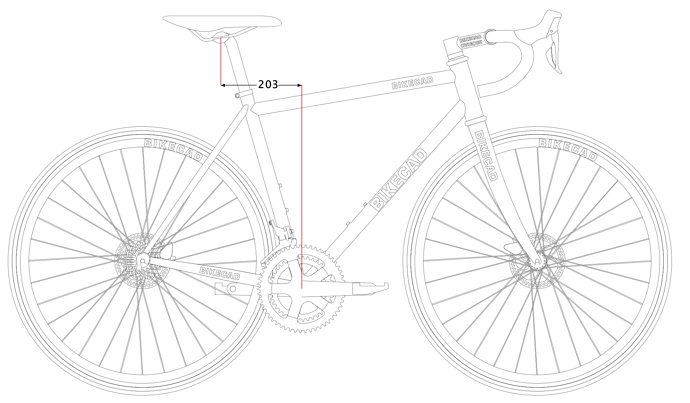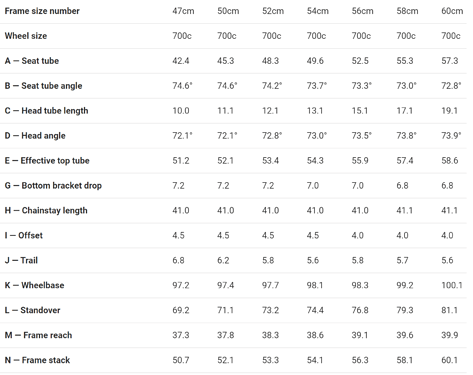Hi everyone,
I’m currently designing a drop bar touring bike, mostly for road and some gravel. I design the frame, the racks and the bags as one integrated system. Weight distribution is influenced by the placement of these bags as well as by the bike’s geometry.
I’m asking myself two questions:
(1) To what degree is fore-aft weight distribution (see exact definition below) a driving design goal for most of the shelf road and gravel bikes?
(2) What would be the ideal weight distribution for the various drop bar bike categories be, if we would not have to pay attention to design goals (such as tire clearance to seat tube, sizing considerations, steering geometry etc) that determine fore-aft weight distribution “as a by product”?
By fore-aft weight distribution I mean the ratio of weight carried by the rear wheel to weight carried by the front wheel, each measured when the rider sits on the bike - or the inverse ratio. The center of mass (fore-aft) of a gravel bike with rider is typically a few centimeters behind the bottom bracket - a little less than half of that when measured in inch ;). This is based on a series of measurements I did where I sat on a gravel bike (an Orbea Terra 2023, size L) with my shoes on the pedals and a digital scale under each wheel. For a road bike the center of mass is a little bit further forward.
After reading What are your driving dimensions and why? and Chainstay Length Discussion it seems that at least people active on the forum give a lot of consideration to fore-aft weight distribution. In the following few paragraphs I will nonetheless argue that, at least to a certain degree, bikes are unlikely to have the “perfect” fore-aft weight distribution because other driving design goals produce weight distribution as a byproduct.
Weight distribution is mostly dictated by (1) the ratio of rear center (i.e. horizontal chain stay length) to front center and (2) seat tube angle. The combination of (1) and (2) put the body of the rider somewhere between rear axle and front axle which determines the weight distribution between the wheels.
(1) Rear center to front center ratio for road and mountain bikes is dictated by (a) sizing and sometimes toe overlap considerations, (b) the preferred cockpit (MTBers like the control/steering lever provided by wide handlebars, roadies like narrower handlebars for aero and ergonomic reasons and longer stems to give these narrow handlebars stability at speed and (c) steering geometry (head tube angle and fork offset).
Neither (a), (b) or (c) is driven by fore-aft weight distribution considerations but they are driving/determining weight distribution as far as front center goes. This is why I said above that “other design goals” determine weight distribution as a by product.
Rear center, i.e. horizontal chainstay length, on road race bikes is often as short as possible in order to create a stiffer, “snappier” rear end and to keep the bikes overall length short in order to be able to maneuver the bike in a bunch quickly - bad at least is the narrative (that sells). On mountain bikes rear center is either also kept as short as possible to be able wheelie and pull the front wheel over obstacles easily or one wants to increase the overall length of the bike which is done by increasing chainstay length (mostly on Downhill bikes for high speed stability on loose ground). A longer wheelbase provides straight line stability and is therefore sometimes a consideration on endurance road bikes and gravel bikes because they do less bunch riding. This is a somewhat crude overview of factors influencing rear center but I hope you get the point across that other design goals determine weight distribution as a byproduct.
(2) Seat tube angle
Seat tube angle on all types of bikes is influenced by (a) pedalling economy (steeper seat tube angle is associated with more physiological power production on road bikes) and (b) a comfortable distribution of body weight between hands and butt (not to be confused with the topic of this post, i.e. distribution of system weight between the two wheels).
On mountain bikes seat tube angle is mainly driven by the need for weight over the front wheel on steep inclines. This is the only major example in bike design where fore-aft weight distribution is the crucial factor that dictates an element of bike geometry.
I’m interested in what the ideal fore-aft weight distribution would be for race road and endurance road if all of these other design goals I mentioned above would not already define fore-aft weight distribution more or less. The reason why this is not only a theoretical question is because on a bike with luggage it is possible to influence the weight distribution greatly while still paying attention to the other design goals mentioned above by placing the luggage further reward or further forward.
If you share your “ideal” weight distribution you could express that as: rc:fc ratio (or the inverse of it) at STA of x for category “road endurance” or whatever other (drop bar) category you have in mind.[1] Rider position on the bike also has a large influence on weight distribution but by stating the bike category (alongside rc:fc ratio and STA) we can assume a category-specific typical rider position. And keep in mind that the “rc:fc ratio at STA of x” statement should not be one’s overall geometry preference given all the conflicting design goals we face in bike design but one that is free from design goals other than fore-aft weight distribution. This at least is the best way I can think of to quantify fore-aft weight distribution. Another way to express it would be to simply say: more rearward/forward than is is typical for a certain by category.
[1] rc:fc = rear centre to front center ratio; STA = seat tube angle.

